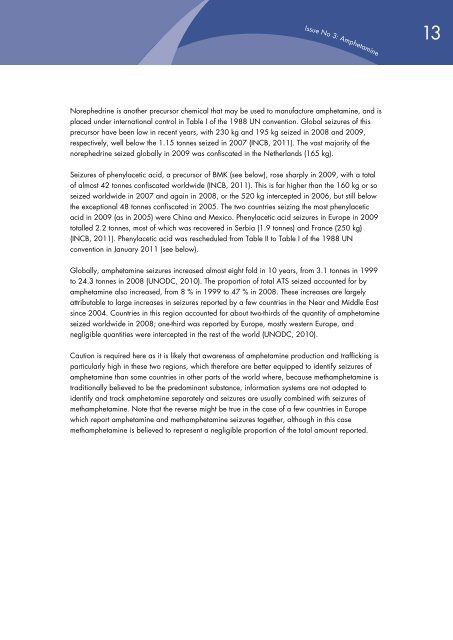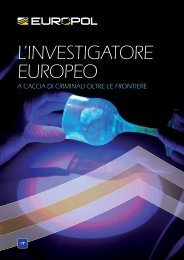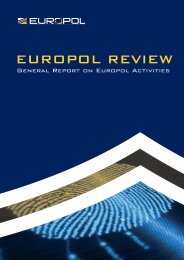EMCDDA–Europol joint publications Amphetamine - Europol - Europa
EMCDDA–Europol joint publications Amphetamine - Europol - Europa
EMCDDA–Europol joint publications Amphetamine - Europol - Europa
Create successful ePaper yourself
Turn your PDF publications into a flip-book with our unique Google optimized e-Paper software.
Issue No 3: <strong>Amphetamine</strong><br />
Norephedrine is another precursor chemical that may be used to manufacture amphetamine, and is<br />
placed under international control in Table I of the 1988 UN convention. Global seizures of this<br />
precursor have been low in recent years, with 230 kg and 195 kg seized in 2008 and 2009,<br />
respectively, well below the 1.15 tonnes seized in 2007 (INCB, 2011). The vast majority of the<br />
norephedrine seized globally in 2009 was confiscated in the Netherlands (165 kg).<br />
Seizures of phenylacetic acid, a precursor of BMK (see below), rose sharply in 2009, with a total<br />
of almost 42 tonnes confiscated worldwide (INCB, 2011). This is far higher than the 160 kg or so<br />
seized worldwide in 2007 and again in 2008, or the 520 kg intercepted in 2006, but still below<br />
the exceptional 48 tonnes confiscated in 2005. The two countries seizing the most phenylacetic<br />
acid in 2009 (as in 2005) were China and Mexico. Phenylacetic acid seizures in Europe in 2009<br />
totalled 2.2 tonnes, most of which was recovered in Serbia (1.9 tonnes) and France (250 kg)<br />
(INCB, 2011). Phenylacetic acid was rescheduled from Table II to Table I of the 1988 UN<br />
convention in January 2011 (see below).<br />
Globally, amphetamine seizures increased almost eight fold in 10 years, from 3.1 tonnes in 1999<br />
to 24.3 tonnes in 2008 (UNODC, 2010). The proportion of total ATS seized accounted for by<br />
amphetamine also increased, from 8 % in 1999 to 47 % in 2008. These increases are largely<br />
attributable to large increases in seizures reported by a few countries in the Near and Middle East<br />
since 2004. Countries in this region accounted for about two-thirds of the quantity of amphetamine<br />
seized worldwide in 2008; one-third was reported by Europe, mostly western Europe, and<br />
negligible quantities were intercepted in the rest of the world (UNODC, 2010).<br />
Caution is required here as it is likely that awareness of amphetamine production and trafficking is<br />
particularly high in these two regions, which therefore are better equipped to identify seizures of<br />
amphetamine than some countries in other parts of the world where, because methamphetamine is<br />
traditionally believed to be the predominant substance, information systems are not adapted to<br />
identify and track amphetamine separately and seizures are usually combined with seizures of<br />
methamphetamine. Note that the reverse might be true in the case of a few countries in Europe<br />
which report amphetamine and methamphetamine seizures together, although in this case<br />
methamphetamine is believed to represent a negligible proportion of the total amount reported.<br />
13







